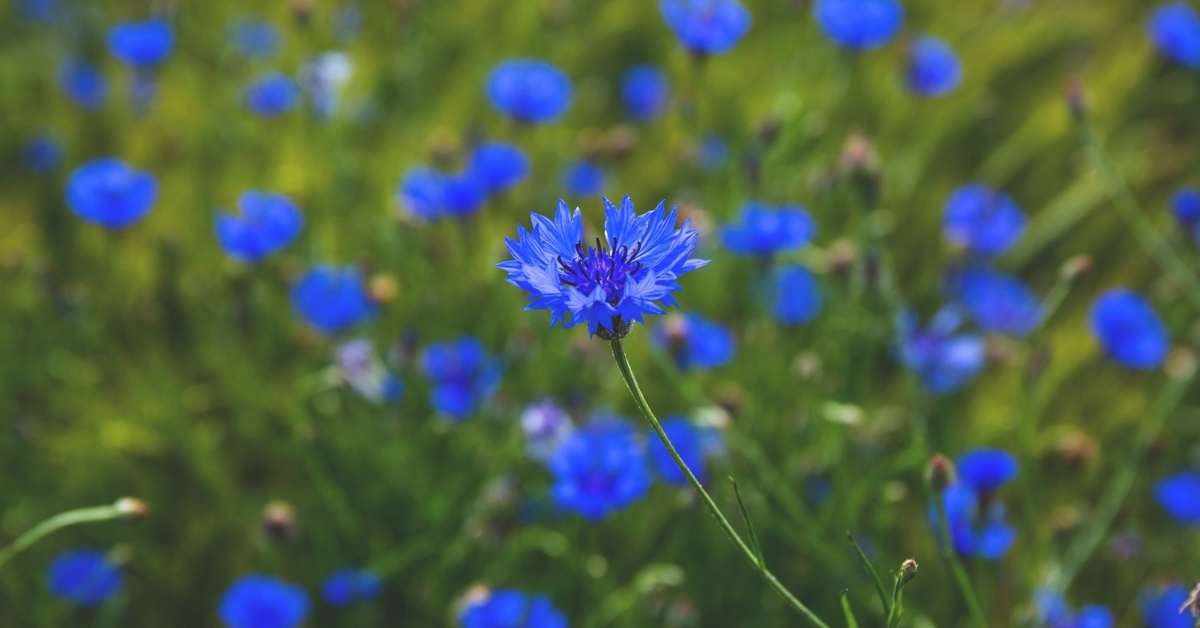Pitcher plants are fascinating carnivorous plants that can thrive in your home or garden. Learn how to care for a pitcher plant, from choosing the right soil and pot to propagating and pruning...
Have you ever wondered what it would be like to grow a plant that eats insects? If you are looking for a unique and fascinating addition to your home or garden, you might want to consider a pitcher plant. Pitcher plants are carnivorous plants that lure, trap, and digest their prey using specialized leaves that resemble pitchers or jugs.
They come in a variety of shapes, sizes, colors, and habitats, ranging from tropical rainforests to temperate bogs. In this article, you will learn how to care for a pitcher plant, from choosing the right soil and pot to propagating and pruning.
Whether you are a beginner or an expert, you will find some useful tips and tricks to help you grow a healthy and beautiful pitcher plant. Read on to discover the secrets of these amazing plants and how to make them thrive in your own space.
Choosing a Pitcher Plant
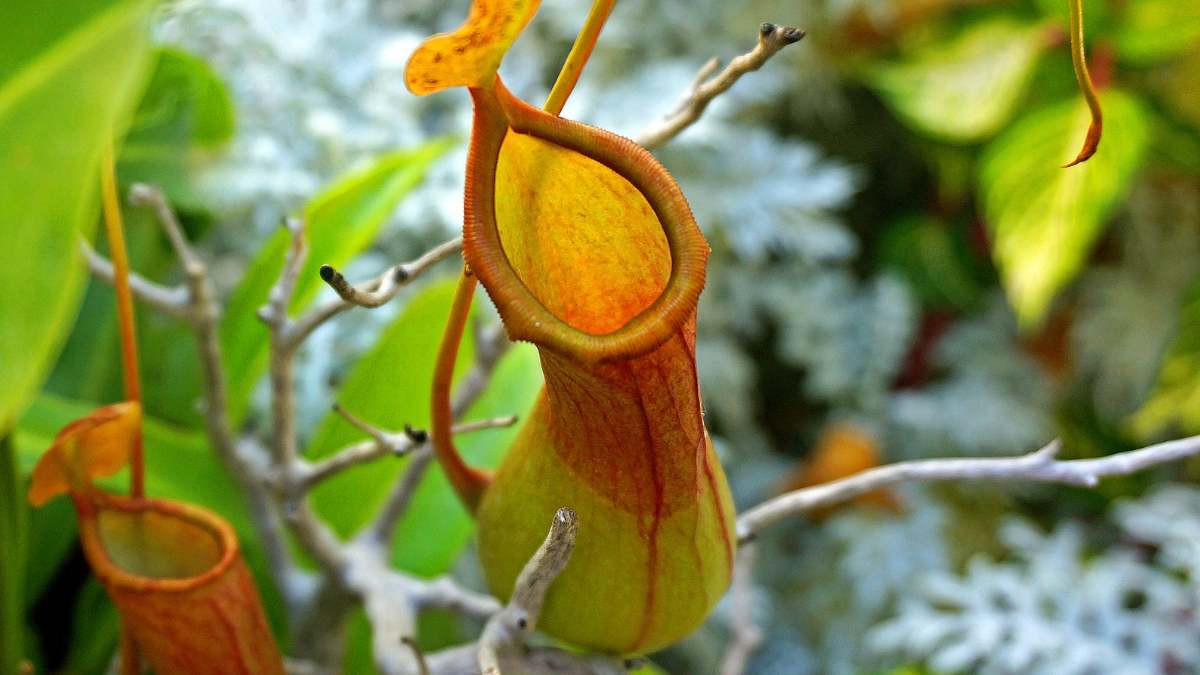
One of the first steps to caring for a pitcher plant is to choose a healthy and suitable plant for your home or garden. There are hundreds of species and hybrids of pitcher plants, each with its own characteristics and requirements.
Factors to consider when choosing a pitcher plant:
Size:
Pitcher plants can vary in size from a few inches to several feet tall. Some pitcher plants, such as the hanging pitcher plant (Tropical Pitcher Plant or the Monkey Cup), have long vines that can reach up to 20 feet in length. Others, such as the Australian pitcher plant, have compact rosettes that can fit in a small pot. Think about how much space you have and how big you want your plant to grow.
Shape:
Pitcher plants have different shapes of leaves and pitchers, depending on their type and origin. Some pitcher plants, such as the nepenthes plant or the genus nepenthes, have slender and elongated pitchers that hang from the tips of the leaves.
Others, such as the carnivorous pitcher plant or the American pitcher plant, have stout and upright pitchers that grow from the base of the leaves. Choose a shape that appeals to you and matches your decor.
Color:
Pitcher plants have a wide range of colors, from green and yellow to red and purple. Some pitcher plants, such as the pitcher plant flower, have colorful and showy flowers that bloom in spring or summer.
Others, such as the types of pitcher plants that grow in low-light conditions, have dark and glossy pitchers that contrast with their surroundings. Choose a color that suits your taste and complements your other plants.
Variety:
Pitcher plants belong to two main families: Sarraceniaceae and Nepenthaceae. The former includes the American pitcher plant, the northern pitcher plant, and the woolly bats and pitcher plants. These plants grow in temperate regions and require cold winters to thrive.
The latter includes the Nepenthes plant, the hanging pitcher plant, and the Australian pitcher plant. These plants grow in tropical regions and require warm and humid conditions to thrive. Choose a variety that matches your climate and environment.
Once you have decided on these factors, you can start looking for a pitcher plant that meets your criteria. You can buy pitcher plants from online stores, nurseries, or specialty shops that sell carnivorous plants. Make sure to buy from a reputable seller that provides healthy and well-grown plants.
Avoid buying plants that have wilted, brown, or damaged leaves or pitchers, as they may be diseased or stressed. Also, avoid buying plants that have been collected from the wild, as they may not adapt well to cultivation and may harm the natural population.
When you receive your pitcher plant, inspect it carefully and remove any dead or diseased parts. Then, prepare the soil and pot for planting, as explained in the next section.
Planting a Pitcher Plant
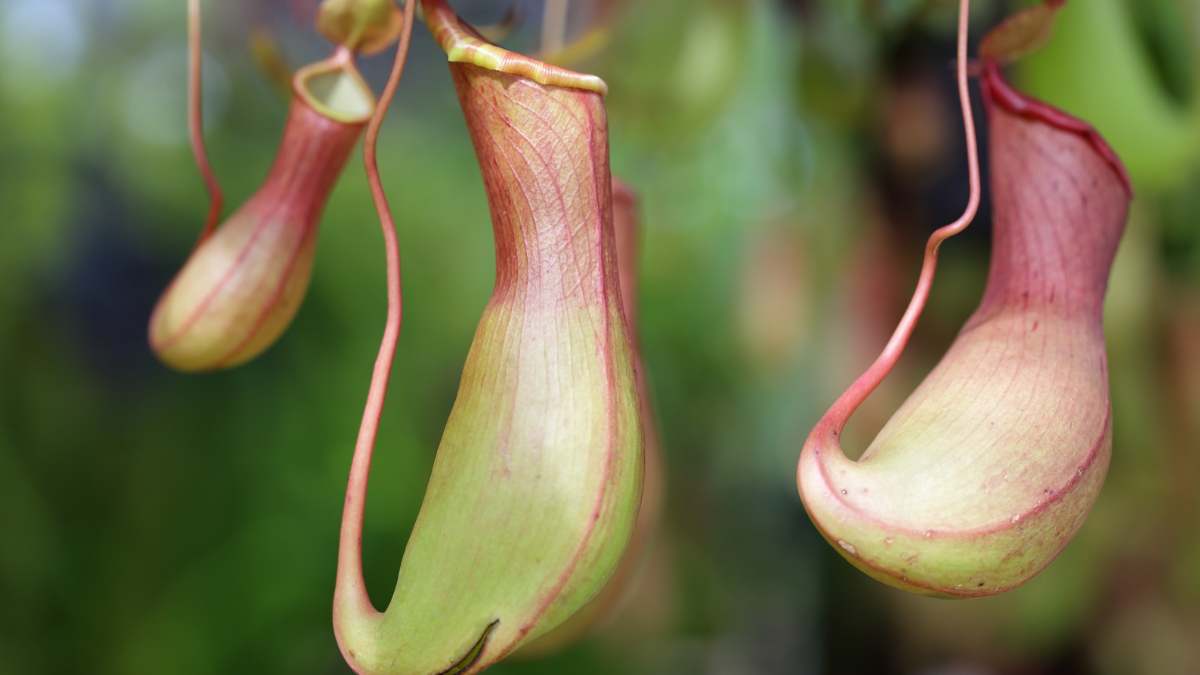
After choosing a pitcher plant, the next step is to plant it in a suitable soil and pot. Pitcher plants have different soil and pot preferences depending on their type and origin. However, there are some general guidelines that apply to most pitcher plants.
Tips on how to prepare the soil and pot for your pitcher plant:
Soil:
Pitcher plants need a well-draining and acidic soil mix that can retain moisture and nutrients. A common soil mix for pitcher plants is composed of equal parts of peat moss, perlite, and sphagnum moss.
Peat moss provides acidity and organic matter, perlite provides drainage and aeration, and sphagnum moss provides moisture and antibacterial properties.
You can also add some sand, vermiculite, or orchid bark to adjust the texture and porosity of the mix. Avoid using regular potting soil, compost, or fertilizer, as they may be too rich or alkaline for your pitcher plant.
Pot:
Pitcher plants need a pot that can accommodate their roots and pitchers without being too large or too small. A common pot size for pitcher plants is 6 to 8 inches in diameter and depth.
You can use plastic, ceramic, or hanging pots for your pitcher plant as long as they have drainage holes at the bottom.
Plastic pots are lightweight and inexpensive, but they may retain too much heat or water. Ceramic pots are heavy and durable, but they may crack or break easily. Hanging pots are ideal for vining pitcher plants, such as the hanging pitcher plant, but they may dry out faster than other pots.
Transplanting:
Pitcher plants need to be transplanted from their original container to their new pot carefully and gently. Here are some steps on how to transplant your pitcher plant:
Fill the new pitcher plant pot with some soil mix, leaving enough space for the root ball of your pitcher plant.
Remove your pitcher plant from its original container by loosening the soil around the edges and lifting it out with your hands. Do not pull or tug on the plant, as you may damage its roots or pitchers.
Place your pitcher plant in the center of the new pot and spread its roots evenly over the soil mix. Make sure that the base of the plant is level with the rim of the pot.
Fill the remaining space with more soil mix, gently pressing it around the roots and pitchers of your pitcher plant. Do not pack or compress the soil too much, as you may reduce its drainage and aeration.
Water your pitcher plant thoroughly until water drains out from the bottom of the pot. Let the excess water drain completely before placing your pitcher plant in its desired location.
How to Care for a Pitcher Plant
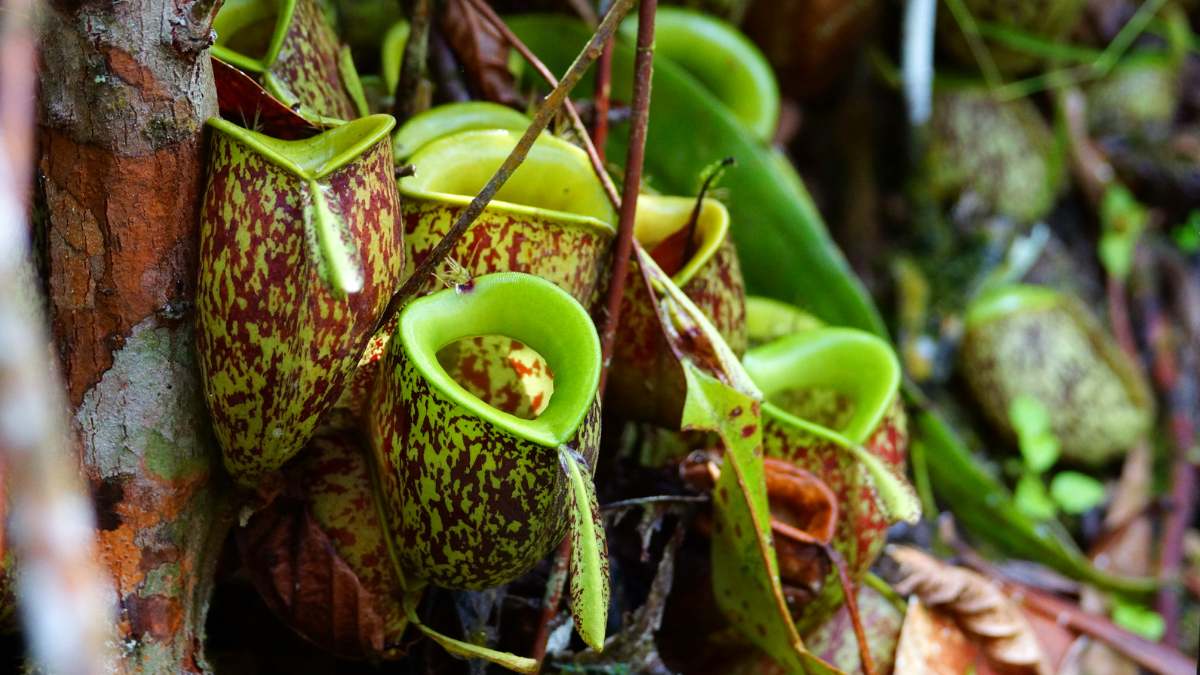
Once you have planted your pitcher plant, the next step is to care for pitcher plant by watering, fertilizing, and pruning it. Pitcher plants have different watering, fertilizing, and pruning needs depending on their type and origin.
However, there are some general guidelines that apply to most pitcher plants. You can follow these tips on pitcher plant care:
Watering:
Pitcher plants need to be watered regularly and thoroughly to keep their soil moist but not soggy. A common watering frequency for pitcher plants is once or twice a week, depending on the season, temperature, and humidity.
You can check the soil moisture by inserting your finger into the soil up to the second knuckle. If the soil feels dry, water your pitcher plant until water drains out from the bottom of the pot. If the soil feels wet, wait until it dries slightly before watering again.
You can also use a moisture meter to measure the soil moisture more accurately. Avoid letting the soil dry out completely or overwatering your pitcher plant, as both can cause stress or damage to your plant.
Fertilizing:
Pitcher plants need to be fertilized occasionally and sparingly to supplement their nutrient intake from insects. A common fertilizing frequency for pitcher plants is once or twice a month during the growing season, which is usually spring and summer.
You can use organic or inorganic fertilizers for your pitcher plant as long as they are diluted and low in nitrogen. Some examples of organic fertilizers are blood meal, fish emulsion, or worm castings. Some examples of inorganic fertilizers are osmocote miracle-gro or orchid food.
You can apply the fertilizer to the soil or to the pitchers of your pitcher plant, depending on the type and strength of the fertilizer. Avoid using too much or too often fertilizer for your pitcher plant, as it may burn its roots or pitchers or inhibit its insect-catching ability.
Pruning:
Pitcher plants need to be pruned occasionally and carefully to remove dead or damaged leaves and pitchers. A common pruning frequency for pitcher plants is once or twice a year, usually in late winter or early spring.
You can use sharp and sterile scissors or pruning shears to cut off the unwanted parts of your pitcher plant, leaving a small stub above the base of the plant.
Avoid cutting off healthy or new leaves or pitchers, as they may help your plant grow and produce more pitchers. Also, avoid cutting off too much or too little of your plant, as it may affect its shape or balance.
You can care for your pitcher plant in a way that enhances its beauty and functionality with these applications. Now, let’s talk about how to propagate your pitcher plant by using seeds or cuttings.
Propagating a Pitcher Plant
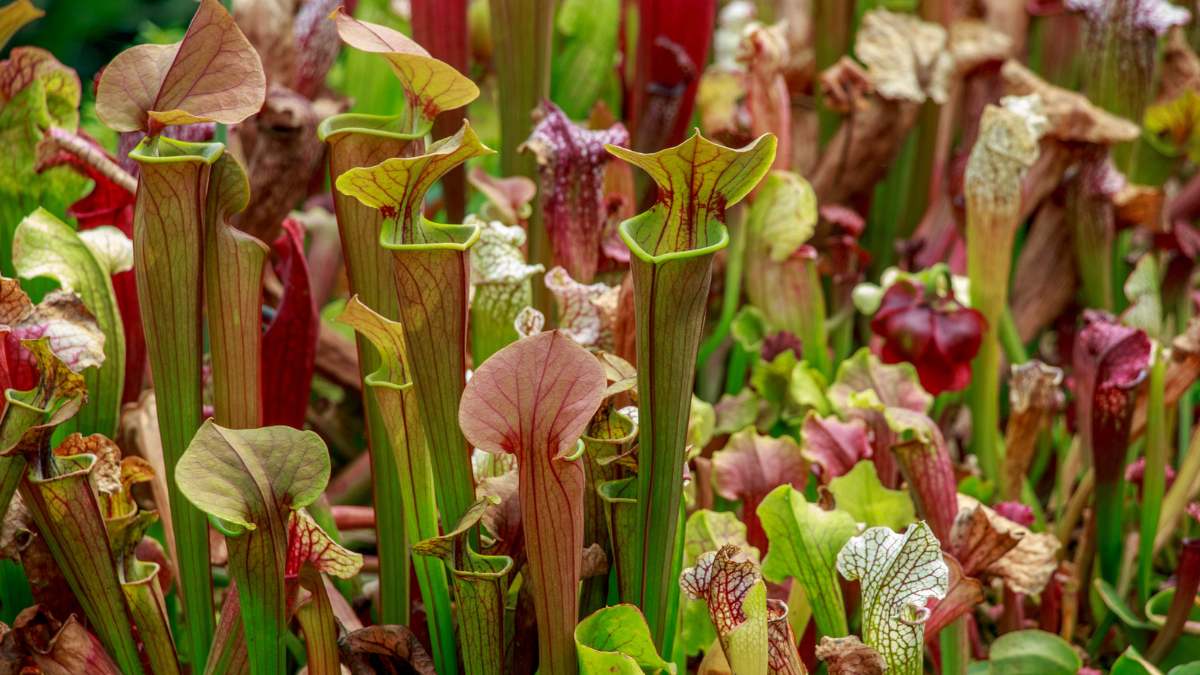
If you want to have more pitcher plants in your home or garden, you can propagate your existing plant by using seeds or cuttings. Pitcher plants can be propagated by either method, but each has its advantages and disadvantages. Here is the information on how to propagate your pitcher plant by using seeds or cuttings:
Seeds:
Pitcher plants can be propagated by sowing pitcher plant seeds or carnivorous plant seeds that you can obtain from your own plant, from other growers, or from online stores.
Propagating by seeds can be rewarding and fun, as you can grow new and unique varieties of pitcher plants. However, propagating by seeds can also be challenging and time-consuming, as it may take months or years for the seeds to germinate and grow into mature plants. Here are some steps on how to propagate your pitcher plant by using seeds:
- Prepare a seed tray or pot with a well-draining and acidic soil mix, such as peat moss, perlite, and sphagnum moss. Moisten the soil mix lightly and evenly.
- Sprinkle the pitcher plant seeds or carnivorous plant seeds over the surface of the soil mix, leaving some space between them. Do not cover the seeds with soil, as they need light to germinate.
- Place the seed tray or pot in a warm and bright location, such as a windowsill, a greenhouse, or under artificial lights. Keep the temperature between 70°F and 85°F and the humidity above 70%.
- Mist the soil mix daily with distilled water or rainwater to keep it moist but not soggy. Do not water the soil mix directly, as it may dislodge or bury the seeds.
- Wait patiently for the seeds to germinate, which may take from a few weeks to a few months, depending on the type and freshness of the seeds. You can check the progress of the seeds by looking for tiny green sprouts emerging from the soil.
- Transplant the seedlings into individual pots when they have at least two true leaves, which are different from the first leaves that appear. Handle the seedlings gently and carefully, as they are fragile and delicate.
Cuttings:
Pitcher plants can also be propagated by taking and rooting propagating pitcher plant cuttings from your existing plant. Propagating by cuttings can be easy and fast, as you can clone your plant and produce identical copies of it.
However, propagating by cuttings can also be risky and limited, as you may damage your plant or reduce its genetic diversity.
Steps on how to propagate your pitcher plant by using cuttings:
- Choose a healthy and vigorous stem or leaf from your pitcher plant that has at least one node, which is where a leaf or a pitcher attaches to the stem. Avoid choosing a stem or leaf that has flowers or buds, as they may divert energy from rooting.
- Cut off the stem or leaf with a sharp and sterile knife or scissors, making a clean and diagonal cut just below the node. You can make several cuttings from one stem or leaf as long as each cutting has at least one node.
- Remove any leaves or pitchers from the lower part of the cutting, leaving only one or two at the top. This will reduce water loss and encourage rooting.
- Dip the cut end of the cutting in a rooting hormone powder or gel, which will stimulate root growth and prevent infection. You can buy rooting hormones from garden centers or online stores.
- Insert the cut end of the cutting into a small pot with a well-draining and acidic soil mix, such as peat moss, perlite, and sphagnum moss. Press the soil mix gently around the cutting to secure it in place.
- Place the pot in a warm and humid location, such as a plastic bag, a dome, or a terrarium. Keep the temperature between 70°F and 85°F and the humidity above 90%.
- Water the soil mix lightly and evenly with distilled water or rainwater to keep it moist but not soggy. Do not mist the cutting directly, as it may cause rotting or fungal infection.
- Wait patiently for the cutting to root, which may take from a few weeks to a few months, depending on the type and condition of the cutting. You can check the progress of the cutting by looking for new growth at the top or by gently tugging on it to feel resistance.
- You can propagate your pitcher plant in a way that suits your preferences and resources.
Let’s continue with the plant pests and diseases and learn how to troubleshoot common problems with pitcher plants.
Troubleshooting Common Problems with Pitcher Plants
Pitcher plants are generally easy to grow and care for, but they may encounter some problems that may affect their health and appearance. Pitcher plants may suffer from pests, diseases, sunburn, wilting, or browning, depending on their type and environment. Here are some tips on how to identify and treat common problems with pitcher plants:
Pests:
Pitcher plants may attract some pests that feed on their leaves, pitchers, or roots, such as aphids, mealybugs, scale insects, spider mites, or fungus gnats. These pests may cause yellowing, curling, or spotting of the plant parts, as well as reduced growth or vigor.
You can prevent or control these pests by inspecting your plant regularly and removing any infested parts. You can also use natural or chemical remedies to kill or repel the pests, such as neem oil, insecticidal soap, or pyrethrin spray.
Apply these remedies according to the instructions and precautions on the label, and avoid spraying them on the pitchers of your plant.
Diseases:
Pitcher plants may contract some diseases that infect their leaves, pitchers, or roots, such as fungal, bacterial, or viral diseases. These diseases may cause wilting, rotting, or blotching of the plant parts, as well as reduced growth or vigor.
You can prevent or control these diseases by keeping your plant clean and healthy and avoiding overwatering or overcrowding. You can also use natural or chemical remedies to cure or prevent the diseases, such as hydrogen peroxide, baking soda, or fungicide.
Apply these remedies according to the instructions and precautions on the label, and avoid applying them on the pitchers of your plant.
Sunburn:
Pitcher plants may get sunburned if they are exposed to too much direct sunlight or high temperatures, especially in summer. Sunburn may cause browning, scorching, or cracking of the leaves or pitchers of your plant, as well as reduced growth or vigor.
You can prevent or treat sunburn by providing your plant with adequate shade and ventilation and avoiding sudden changes in light or temperature. You can also use a sunscreen spray or a shade cloth to protect your plant from excessive sun exposure.
Wilting:
Pitcher plants may wilt if they are under-watered or over-watered, especially in winter. Wilting may cause drooping, shriveling, or collapsing of the leaves or pitchers of your plant, as well as reduced growth or vigor.
You can prevent or treat wilting by watering your plant properly and regularly and avoiding waterlogging or drought. You can also use a moisture meter or a finger test to check the soil moisture before watering your plant.
Browning:
Pitcher plants may turn brown if they are stressed or aging, especially in autumn. Browning may cause discoloration, drying, or falling off of the leaves or pitchers of your plant, as well as reduced growth or vigor.
You can prevent or treat browning by providing your plant with optimal conditions and care and avoiding stress factors such as pests, diseases, sunburn, wilting, etc. You can also prune off any brown parts of your plant to improve its appearance and health.
15 Varieties of Pitcher Plants
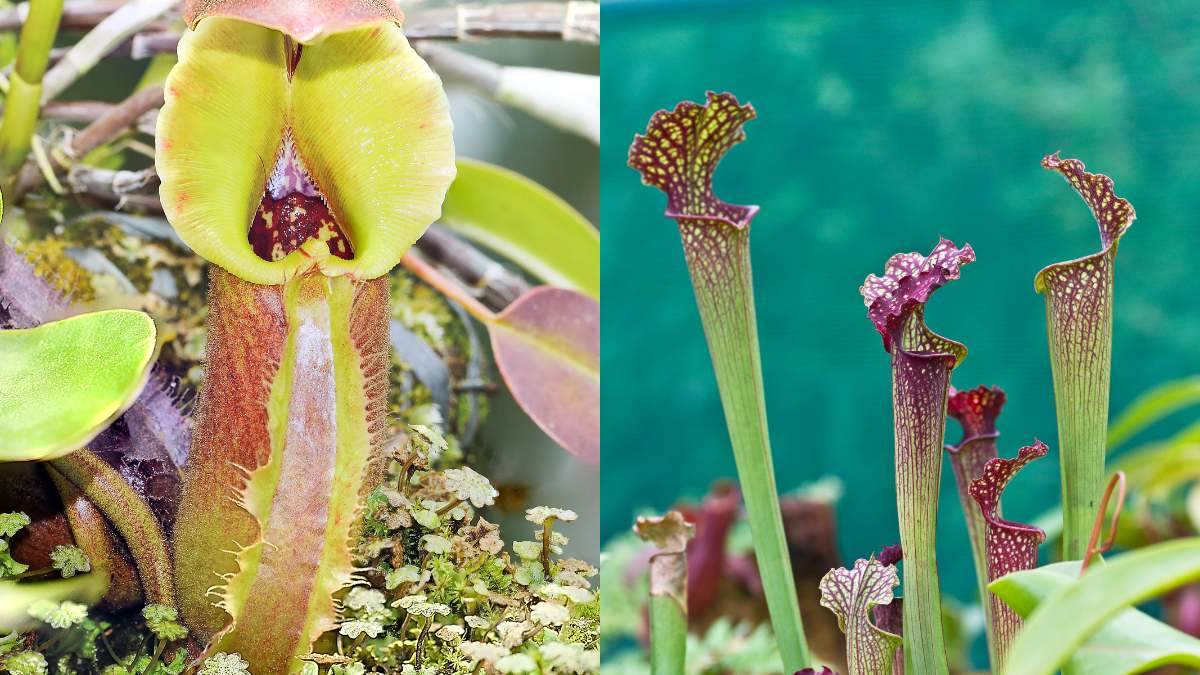
The term “pitcher plant” generally refers to members of the Nepenthaceae and Sarraceniaceae families, which are the most species-rich families of pitcher plants. The Nepenthaceae contains a single genus, Nepenthes, containing over 100 species and numerous hybrids and cultivars. The Sarraceniaceae contains three genera, Heliamphora, Sarracenia, and Darlingtonia, containing about 30 species and many hybrids and cultivars. However, similar pitfall traps are also employed by the monotypic Cephalotaceae family and some members of the Bromeliaceae family.
Some of the most popular and common varieties of pitcher plants that you can grow and enjoy:
- Purple Pitcher Plant (Sarracenia purpurea): This is one of the most widespread and hardy pitcher plants, native to North America. It has purple-red flowers and vein-marked pitchers that grow close to the ground. It can tolerate cold winters and wet soils, making it ideal for water gardens or bogs.
- California Pitcher Plant (Darlingtonia californica): This is a unique and rare pitcher plant native to California and Oregon. It has green flowers and cobra-shaped pitchers that have an inflated lid and a forked tongue. It grows in cool and moist habitats, such as mountain streams or seeps.
- Cephalotus Follicularis: This is the only species in the Cephalotaceae family, native to Western Australia. It has small white flowers and hairy pitchers that resemble tiny helmets or cups. It grows in sandy and peaty soils in coastal or swampy areas.
- Nepenthes Mirabilis: This is one of the most widespread and adaptable Nepenthes species, native to Southeast Asia and Australia. It has yellow-green flowers and slender pitchers that vary in color from green to red. It grows in a variety of habitats, such as forests, grasslands, or mangroves.
- Nepenthes Attenboroughii: This is one of the largest and rarest Nepenthes species, native to the Philippines. It has pink flowers and giant pitchers that can hold up to two liters of liquid. It grows in high-altitude forests, on steep slopes or cliffs.
- Nepenthes alata: This is one of the most common and easy-to-grow Nepenthes species, native to the Philippines. It has red flowers and elongated pitchers that have prominent wings or alae. It grows in sunny and humid habitats, such as open forests or scrublands.
- Sarracenia Leucophylia: This is one of the most beautiful and striking Sarracenia species, native to the Southeastern United States. It has red flowers and white-topped pitchers that have red veins and spots. It grows in sunny and wet habitats, such as bogs or pine savannas.
- Yellow Pitcher Plant (Sarracenia flava): This is one of the tallest and most impressive Sarracenia species, native to the Southeastern United States. It has yellow flowers and yellow-green pitchers that have red lids and throats. It grows in sunny and wet habitats, such as bogs or pine savannas.
- Nepenthes rafflesiana: This is one of the most variable and ornamental Nepenthes species, native to Southeast Asia. It has pink flowers and large pitchers that have frilled lids and spotted peristomes. It grows in shady and humid habitats, such as lowland forests or swamps.
- Nepenthes ampullaria: This is one of the most unusual and distinctive Nepenthes species, native to Southeast Asia and Australia. It has green flowers and short pitchers that have round lids and narrow mouths. It grows in shady and moist habitats, such as peat swamps or heath forests.
- Nepenthes ventricosa: This is one of the most popular and reliable Nepenthes species, native to the Philippines. It has purple flowers and bulbous pitchers that have smooth lids and wide peristomes. It grows in cool and misty habitats, such as montane forests or ridges.
- Nepenthes Veitchii: This is one of the most colorful and spectacular Nepenthes species, native to Borneo. It has red flowers and cylindrical pitchers that have striped lids and ribbed peristomes. It grows in sunny and windy habitats, such as highland forests or cliffs.
- Sarracenia Rubra: This is one of the smallest and most delicate Sarracenia species, native to the Southeastern United States. It has red flowers and red-brown pitchers that have narrow lids and curved lips. It grows in shady and wet habitats, such as bogs or seeps.
- Nepenthes truncata: This is one of the most robust and vigorous Nepenthes species, native to the Philippines. It has yellow flowers and massive pitchers that have truncated lids and thick peristomes. It grows in hot and dry habitats, such as open forests or grasslands.
- Sun Pitcher Plant (Heliamphora spp.): This is a group of pitcher plants native to South America. They have white or pink flowers and simple pitchers that have a spoon-like structure that secretes nectar. They grow in cool and wet habitats, such as tepuis or table mountains.
These are some of the different varieties of pitcher plants that you can choose from. Each one has its own charm and appeal, as well as its own needs and preferences. You can learn more about each variety by doing some research or asking other growers. You can also experiment with different combinations and arrangements of pitcher plants to create your own stunning and functional display.
Conclusion
Pitcher plants are amazing carnivorous plants that can add beauty and interest to your home or garden. In this article, you have learned how to care for a pitcher plant, from choosing the right soil and pot to propagating and pruning.
You have also learned how to troubleshoot common problems with pitcher plants and keep them healthy and happy. By following these tips and tricks, you can grow a pitcher plant that will reward you with its stunning and functional pitchers.
Whether you are a beginner or an expert, you can enjoy the wonders of these plants and their insect-catching abilities.
Are you ready to try growing a pitcher plant in your own space? Do you have any questions or comments about caring for a pitcher plant? Let us know in the comments section below. We would love to hear from you!
FAQ
What kind of water should I use for my pitcher plant?
You should use distilled water or rainwater for your pitcher plant, as they are pure and free of minerals or chemicals that may harm your plant. Avoid using tap water, bottled water, or filtered water, as they may contain chlorine, fluoride, or salts that may alter the pH or nutrient balance of your plant.
How often should I feed my pitcher plant?
You do not need to feed your pitcher plant, as it can catch and digest its own insects. However, you can supplement its diet with some organic or inorganic fertilizers once or twice a month during the growing season. You can also feed it some live or dead insects, such as flies, ants, or crickets, once or twice a year. Avoid feeding it meat, cheese, or other human foods, as they may cause rotting or infection in your plant.
How can I make my pitcher plant produce more pitchers?
You can make your pitcher plant produce more pitchers by providing it with optimal conditions and care. Make sure to give it enough light, water, humidity, and fertilizer, and avoid stress factors such as pests, diseases, sunburn, wilting, etc. You can also prune off any dead or damaged leaves or pitchers to stimulate new growth. Some pitcher plants may also produce more pitchers in response to seasonal changes in temperature or day length.

